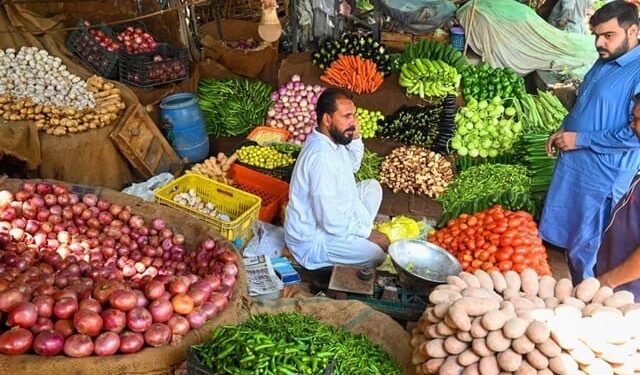ISLAMABAD :As Pakistan enters the new fiscal year 2025–26, the country is already witnessing a noticeable upsurge in inflation, causing concern among households, economists, and policymakers alike. According to the latest weekly inflation report issued by the Federal Bureau of Statistics (FBS), inflationary pressures have intensified, with the weekly Sensitive Price Indicator (SPI) showing a 0.73% increase, while the annual inflation rate has risen from 1.52% to 2.06%.
The report reveals that prices of 18 essential food and utility items have increased, while 6 items became cheaper and 27 remained unchanged. This reflects a broader trend of economic uncertainty and cost-of-living pressures for the average Pakistani citizen, especially in lower-income groups.
Rising Inflation in Early Fiscal Year 2025–26: An Overview
The increase in prices at the very beginning of the fiscal year is being seen as a continuation of persistent inflationary cycles that have affected Pakistan’s economy for over a year. Factors such as currency depreciation, fuel price hikes, supply chain disruptions, and seasonal fluctuations in agricultural products have been consistently contributing to price volatility.
The Bureau’s weekly inflation assessment, based on the Sensitive Price Index (SPI), serves as a reliable indicator of short-term consumer price changes in essential goods and services.
Price Hike Breakdown: What Became More Expensive?
Here’s a detailed look at the essential items that have seen significant price increases in the past week:
- Live Chicken: Increased by Rs 40 per kilogram
- Onions: Rose by Rs 5.56 per kilogram
- Tomatoes: Jumped by Rs 8 per kilogram
- Garlic: Surged by Rs 18 per kilogram
- Potatoes: Went up by Rs 3 per kilogram
- Sugar: Increased by Rs 1.52 per kilogram
In addition to these, rice, various types of lentils (daal), diesel fuel, curd (dahi), and mutton also recorded a hike in their prices.
These essential kitchen staples are used by every household daily, and such increases are directly impacting the monthly grocery bills of millions of families.
Items That Became Cheaper: Some Relief but Not Enough
While most essential items became more expensive, a few products did register slight decreases in price:
- Domestic LPG Cylinder: Dropped by Rs 302.23
- Eggs (per dozen): Fell by Rs 2
- Moong Dal: Reduced by Rs 1 per kilogram
- Gram Lentils, Mustard Oil, and some other pulses also witnessed marginal reductions
Though these price drops offer limited relief, they are not enough to counterbalance the broader cost pressures facing households—especially considering the heavier weight of meat, vegetables, and fuel in everyday expenses.
Income-Wise Impact: Inflation Hits Lower-Income Groups the Hardest
The report provides a granular analysis of the impact of inflation across various income brackets, revealing that low and middle-income groups are more vulnerable to price increases. Here’s a breakdown of the impact on different income categories:
1. Income up to Rs 17,732/month:
- Weekly Inflation: +0.74%
- Annual Inflation Rate: -3.02%
2. Income Rs 17,733 to Rs 22,888/month:
- Weekly Inflation: +0.80%
- Annual Inflation Rate: -3.93%
3. Income Rs 22,889 to Rs 29,517/month:
- Weekly Inflation: +0.72%
- Annual Inflation Rate: -2.37%
4. Income Rs 29,518 to Rs 44,175/month:
- Weekly Inflation: +0.76%
- Annual Inflation Rate: -1.51%
5. Income above Rs 44,176/month:
- Weekly Inflation: +0.70%
- Annual Inflation Rate: -0.72%
The data clearly shows that even though the annual inflation rate has turned slightly negative due to a statistical base effect or seasonal factors, the weekly burden of rising prices continues to mount, especially on lower-income households.
Causes Behind the Inflation Spike
Several economic and structural factors are driving this renewed surge in prices as the fiscal year 2025–26 begins:
1. Fuel Price Hikes
The global rise in crude oil prices and the weakening of the Pakistani Rupee against the U.S. dollar have led to higher local fuel prices. Since diesel and petrol are crucial for transport and agricultural machinery, their increase translates into higher costs across all commodities, especially food.
2. Disrupted Supply Chains
Flooding in parts of the country, logistical bottlenecks, and ongoing recovery from the global supply chain crisis have created gaps in distribution networks, contributing to erratic price movements.
3. Seasonal Agricultural Fluctuations
Vegetables like tomatoes, onions, and potatoes are particularly susceptible to seasonal changes. A delayed or weak harvest immediately affects prices, as seen in this week’s report.
4. Export Policies and Stock Hoarding
Export of certain commodities such as sugar earlier this year has led to domestic shortages. Additionally, hoarding by suppliers and wholesalers is exacerbating scarcity and pushing prices higher.
Government Measures and Outlook
To mitigate the impact of rising inflation, the Ministry of Finance and the Federal Bureau of Statistics are expected to recommend:
- Strict price monitoring through DCs and provincial governments
- Increased imports of critical food items such as pulses and vegetables
- Subsidized utility stores to help the lower-income segments
- Control measures against hoarders and speculative pricing
However, experts believe that unless structural economic reforms, agricultural investments, and fiscal discipline are enforced, inflationary pressures are likely to persist throughout the fiscal year.
Impact on Consumers: A Growing Sense of Economic Anxiety
The working class and salaried employees are particularly affected by these frequent price shocks. Rising costs of essential items mean smaller disposable incomes, difficulty in saving, and an increased reliance on credit or loans.
Many consumers, especially in urban areas, have started cutting back on nutritional food items, shifting to cheaper and often less healthy alternatives, which could have long-term public health consequences.
Conclusion: A Rocky Start to Fiscal Year 2025–26
As the government embarks on its economic journey for FY 2025–26, the early signs are concerning. Rising inflation, especially in the food sector, suggests that immediate and proactive measures are required to protect vulnerable communities.
While some seasonal and statistical factors may normalize over time, deeper economic imbalances remain. The government must focus on enhancing agricultural output, improving supply chain infrastructure, and ensuring transparent market practices to provide lasting relief to citizens.

























